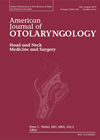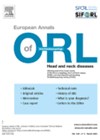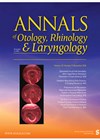
Journal Reviews
In the West of Scotland, what factors impact and what are the survival trends for laryngeal cancer?
The TV and radio presenter Jamie Theakston recently returned to his radio show to announce he is cancer free. He had been off air for a year after having surgery to treat early-stage laryngeal cancer. His diagnosis was made when...
Outcomes of reirradiation for recurrent head and neck SCC
Recurrent squamous cell carcinoma of the head and neck is often a challenge to manage when radiotherapy has previously been administered as a component of the initial treatment. Salvage surgery is usually the preferred modality of treatment, but for unresectable...
Bones, stones and surgical moans: rethinking PTH dynamics in parathyroid surgery
Intraoperative parathyroid hormone (IOPTH) testing has revolutionised minimally invasive unilateral parathyroidectomy (MIP) as the gold standard treatment for primary hyperparathyroidism, replacing old-timey four-gland exploration. IOPTH testing ensures reliable excision of all hypersecreting glands, including those pesky hard-to-find ones, without relying...
Quinsy and culture
Peritonsillar abscesses are frequently encountered in clinical practice. Standard treatment includes empirical medical treatment and drainage. This study aimed at evaluating the value of culture and sensitivity testing of the aspirate in guiding antibiotic treatment. Patients received empirically amoxycillin, amoxycillin...
One-stage laryngotracheal reconstruction in young infants
Airway inadequacy is a significant problem in young infants and may go undetected until inflammatory conditions trigger acute episodes, some of which require a tracheostomy. In addition to breathing difficulties, feeding problems are also common. This study involves 11 children...
AI in ENT practice
Artificial intelligence (AI) technologies are becoming increasingly prevalent in our lives and there has been both enthusiasm and caution for using AI in healthcare. A recent article in the Journal of the American Medical Association reported on a trial examining...
Outcomes of office-based biopsies for laryngopharyngeal carcinoma – faster diagnoses and equivalent oncological outcomes as compared to biopsies under general anaesthesia
Patients in the UK with head and neck cancers are the most likely to face long waits to treatment in comparison to other cancer sites, with only just over half commencing treatment within 62 days of being referred on a...
Maxillomandibular advancement and airway morphology
This is a cadaveric study comparing alterations in airway volume. Seven advancements of the maxillomandibular complex were undertaken, each with a 2 mm incremental advancement being scanned with a total of eight scans per cadaver. They showed that comparisons between...
COVID-19 and oral cancer
This is a Canadian retrospective paper covering the period of March 2018 to March 2022. It identified 190 patients; 91 pre-pandemic and 99 from the pandemic. From this, they found there was no increase in patient delay, professional delay or...
Tonsillectomies are a pain in the neck!
You thought tonsilitis was bad? Having your tonsils removed, now that’s a hard pill to swallow. Very well, you’ll no longer have to fear the CENTOR, but how do we make recovery as pain-free as possible? Pantabtim and colleagues set...
Poking the bear: learning to drain quinsy on a mannequin head
Simulation in medicine has gained significant traction in both undergraduate and postgraduate training over the last couple of decades or so – the benefits to all involved are clear. The airline industry models for human factors and crew resource management...
Volume changes in hemiglossectomy reconstruction
This paper analyses the volume changes in 10 patients, five of whom had hemiglossectomy reconstruction with a radial forearm free flap, whilst the other five patients had reconstruction with an anterolateral thigh flap. Both groups underwent postoperative radiotherapy. The volume...















